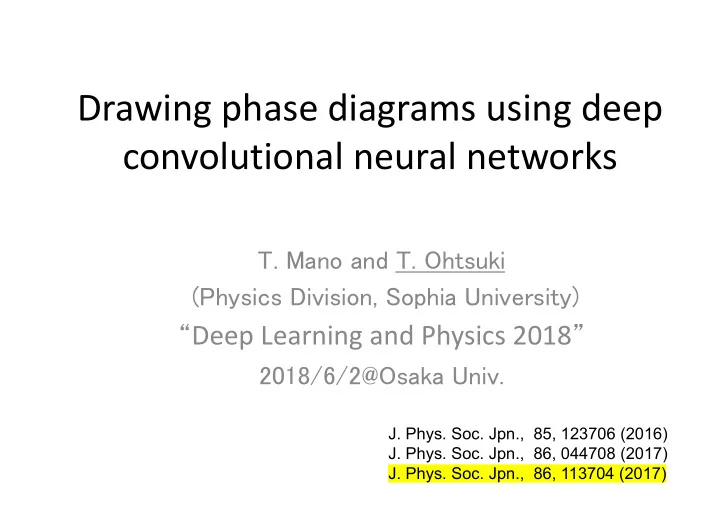

Drawing phase diagrams using deep convolutional neural networks ������� �������������� ������������������������������������� � Deep Learning and Physics 2018 � �������������������� J. Phys. Soc. Jpn., 85, 123706 (2016) J. Phys. Soc. Jpn., 86, 044708 (2017) J. Phys. Soc. Jpn., 86, 113704 (2017)
outline • Analyze the wave function using deep convolutional neural network à phase diagram for quantum phase transition • What is Anderson metal-insulator transition (delocalization-localization transition)? • Deep 3d convolutional neural network approach (image recognition) • Various types of Anderson transitions • Quantum percolation transitions • Application to random topological insulator: real vs. k -space analysis 2
Anderson localization • Wave propagation in random medium à constructive and destructive interferences (wave can be electron, microwave, light, sound, matter waves) à localization of wave (P.W. Anderson, ‘58) Ubiquitous phenomena in many fields of physics 3
Anderson localization • Eigenfunctions are exponentially localized ⎛ ⎞ Ψ ( x ) = a ( x )exp − | x − x 0 | | ψ ( x , y )| 2 ⎜ ⎟ ξ ⎝ ⎠ Red-green, 80%. Red-green-blue, 99% Slevin –Ohtsuki ‘12 �
3d delocalized-localized w.f. Insulator (localized) Metal (delocalized) 5
Anderson Model Non-interacting, random Hamiltonian , − W 2 < ε j < W ∑ ∑ H = ε j j j + V j ', j j ' j 2 j j ', j In magnetic fields U(1) matrix In the presence of spin-orbit interaction ∑ ∑ H = ε j j , σ j , σ + V j ', σ ', j , σ j ', σ ' j , σ j , σ j ', j , σ , σ ' 6 SU(2) matrix
Lyapunov exponent and quasi 1D localization length Transfer matrix E ψ n = H n ψ n + V n , n + 1 ψ n + 1 + V n , n − 1 ψ n − 1 ⎛ ⎞ ⎛ ⎞ ψ n + 1 ψ n ⎟ = T n ⎜ ⎜ ⎟ V n + 1, n ψ n V n , n − 1 ψ n − 1 ⎝ ⎠ ⎝ ⎠ ⎛ ⎞ n ψ n ≈ exp − ⎜ ⎟ ξ q 1 D ( L ) ⎝ ⎠ n -1 n n +1
Finite size scaling analysis ⎧ L 2 − d (delocalized, metal) ⎪ ⎪ 1/ ν ( W − W c )) = Γ ( L ) = F ( L / ξ ) = f ( L Γ c (critical) L / ξ q1d ( L )= ⎨ ⎪ L / ξ (localized, insulator) ⎪ ⎩ L L W c Slevin-Ohtsuki 2012 metal insulator
Limit of transfer matrix • If the matrix elements between sites on n -th layer and n +1th layer, V n,n+1 = ⟨ n | H | n +1 ⟩ , is not invertible, we can not use transfer matrix. – This happens in the case of bcc and fcc lattices, quantum percolation and of localization on fractal lattice. • To draw a phase diagram in W - E space, – Fix E , change W , do FSS and obtain W c ( E ). – Then change E to E ’ and fix it, change W , FSS, W c ( E’ ). – …..
Use 3D image recognition • 3D convolutional neural network • Train the neural network for a simple case, and use the trained neural network to analyze the more complex situations/systems. – Simple model: Anderson model of localization at the band center E =0. à used for training the neural network. – Application to • | E |>0 • In the presence of magnetic field • Random lattice (ex. quantum percolation)
Models • Anderson model , − W 2 < ε j < W ∑ ∑ H = ε j j j + V j ', j j ' j 2 j j ', j • Quantum percolation * + ⟨*| , $ ! = ∑ % & ,% | ⟩ %+,% =0 or 1 $ Sites/bonds are occupied with probability p . For p > p c , a cluster connecting left side to right appears. https://en.wikipedia.org/wiki/Percolation_theory#/media/ File:Bond_percolation_p_51.png
3D CNN CONVOLUTION �� ����������� ��������� CONVOLUTION POOLING CONVOLUTION ����� ��� ��� � CONVOLUTION POOLING CONVOLUTION Diagonalize 14< W <16 17< W <19 Anderson model CONVOLUTION Size 40 � 40 � 40 Select E =0 POOLING 4000 eigen functions for metal and ins. DENSE
Deep (9 weight layer) CNN 3D Anderson transition � �� (3�2�� ���a ������������c��� �������ja�������������c��c� ���� ������ �����������c� �c����� ������ ��c������c �u���c����� ������ �a0I�O[G�OUT ��������c�� �UL�SG] ��� �� �KI�OLOKJ�:OTKG�� ��� BTO���K:B ��i�a ��������� �������� 3�UVUZ� �ip�m����c����t�a� transfer matrix + FSS �� Mano-Ohtsuki, JPSJ ‘17 �
Wave function of Anderson model vs. quantum percolation Anderson model quantum percolation Ujfalusi and Varga, PRB ‘14
Phase diagram for quantum percolation =metal =metal � � � � � � � � � =insulator � Site percolation ; T. Mano and TO: J. Phys. Soc. Jpn. 86 , 113704 (2017) (white dashed line, Ujfalusi and Varga, ‘14 )
Recommend
More recommend